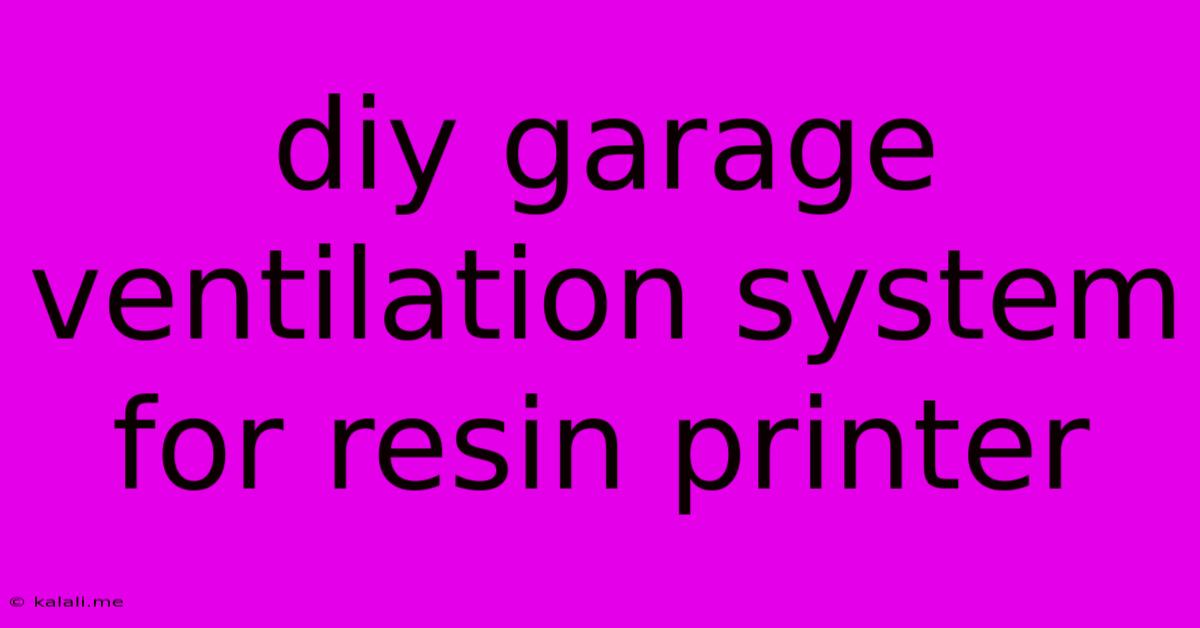Diy Garage Ventilation System For Resin Printer
Kalali
Jun 02, 2025 · 3 min read

Table of Contents
DIY Garage Ventilation System for Your Resin Printer: A Comprehensive Guide
Meta Description: Learn how to build a DIY ventilation system for your resin printer to keep your garage safe and healthy while 3D printing. This guide covers essential components, safety precautions, and step-by-step instructions.
Working with resin 3D printers in a garage environment presents unique challenges. The volatile organic compounds (VOCs) released during the curing process can be harmful if not properly managed. A well-designed ventilation system is crucial for maintaining a safe and healthy workspace. This guide will walk you through building a DIY ventilation system specifically tailored for your resin printer, ensuring both your safety and the longevity of your equipment.
Why is Ventilation Crucial for Resin Printing?
Resin printers utilize photopolymer resins, which contain potentially harmful chemicals. These chemicals, released as VOCs during the printing and curing process, can cause:
- Respiratory problems: Inhalation of these VOCs can lead to irritation, headaches, and in severe cases, more serious respiratory issues.
- Skin irritation: Skin contact with uncured resin can cause allergic reactions and irritation.
- Eye irritation: Resin fumes can irritate the eyes.
- Damage to the printer: Poor ventilation can lead to resin buildup inside the printer, potentially causing malfunctions.
Therefore, proper ventilation is not just a good idea, it's a necessity for anyone using a resin printer.
Components of Your DIY Ventilation System
Building an effective ventilation system involves several key components:
- Exhaust Fan: A powerful exhaust fan is the heart of your system. Consider a fan with a high CFM (Cubic Feet per Minute) rating to ensure efficient air exchange. Look for fans specifically designed for dust and fumes.
- Filter (Optional but Recommended): A high-efficiency particulate air (HEPA) filter can significantly reduce the amount of airborne particles escaping the ventilation system. This adds an extra layer of protection.
- Flexible Ducting: Flexible ducting connects the fan to the printer and guides the air efficiently. Ensure you select ducting that's compatible with the fan and resistant to the chemicals in resin fumes.
- Mounting Brackets and Clamps: Securely mounting your fan and ducting is crucial. Use sturdy brackets and clamps to prevent accidental detachment.
- Activated Carbon Filter (Highly Recommended): An activated carbon filter placed inline with the ducting will absorb a significant portion of the VOCs, further improving air quality.
Step-by-Step Guide to Building Your System
-
Planning and Measurement: Measure the distance between your printer and the desired exhaust point (often a window or exterior wall). This determines the length of ducting needed. Consider the fan's placement for optimal airflow.
-
Assembling the System: Connect the ducting to your exhaust fan. If using a filter or carbon filter, place it securely within the ducting. Attach the other end of the ducting to your resin printer's enclosure or create a custom enclosure around the printer to direct the fumes towards the exhaust.
-
Secure Mounting: Use brackets and clamps to securely mount the exhaust fan and ductwork to prevent vibrations and accidental dislodgement.
-
Testing the System: Run the fan and ensure that it effectively removes air from the printing area. Observe for any leaks or weak points in the ducting.
-
Placement and Maintenance: Ensure the exhaust fan vents to the outside. Regularly check and clean the filter(s) to maintain optimal performance. Replace filters as needed based on manufacturer recommendations.
Safety Precautions
- Always work in a well-ventilated area, even with a ventilation system.
- Wear appropriate personal protective equipment (PPE), including gloves, a respirator mask, and safety glasses.
- Follow the manufacturer's instructions for your resin printer and always handle resin carefully.
- Never leave a running printer unattended.
- Regularly inspect your ventilation system for any signs of damage or wear.
Conclusion
Building a DIY ventilation system for your resin printer is a worthwhile investment in your safety and health. By carefully selecting the right components and following the steps outlined above, you can create a safe and efficient workspace for your 3D printing endeavors. Remember, safety should always be your top priority when working with resin. This project requires careful planning and execution; if unsure about any aspect, consult a professional.
Latest Posts
Latest Posts
-
Conditional Filter On Edit Screen Salesforce
Jun 04, 2025
-
Can You Put Coconut Oil On Cats
Jun 04, 2025
-
How To Remove Top Bar On Mac In Quicktime Player
Jun 04, 2025
-
Can Perl Work On Any Server
Jun 04, 2025
-
How To See All Open Windows On Mac
Jun 04, 2025
Related Post
Thank you for visiting our website which covers about Diy Garage Ventilation System For Resin Printer . We hope the information provided has been useful to you. Feel free to contact us if you have any questions or need further assistance. See you next time and don't miss to bookmark.